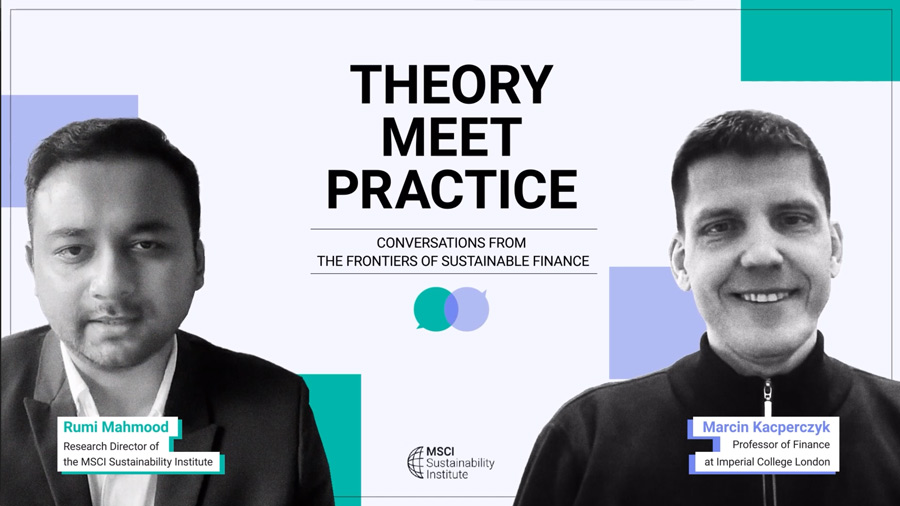How realistic is it for institutional investors to uphold their climate commitments to finance decarbonization, is misalignment with climate goals equivalent to exposure to transition risk, and would convergence between the hodgepodge of frameworks and approaches accelerate financing the transition to a low-carbon economy?
Those were the central questions at a roundtable hosted by the MSCI Sustainability Institute on Monday that convened 26 leaders from finance, government and civil society to examine challenges to financing the climate transition.
The gathering marked the start of Climate Week NYC and arrived in a year when investors have cited challenges to financing the transition as reasons to walk back climate commitments.
Held under Chatham House rule to encourage candor, the discussion surfaced how investors and policymakers alike are navigating the current landscape and whether the frameworks and policies developed thus far are helping or hindering progress.
Challenges to meeting net-zero commitments in practice
Progress in financing the climate transition has been mixed. Though 40% of listed companies have set a net-zero target and nearly half (47%) of companies have disclosed emissions from their value chain, listed companies are expected to burn through their remaining 1.5°C-aligned carbon budget by October 2026, the Institute’s latest Net-Zero Tracker finds. The results of a review published by the European Central Bank in April “cast doubt on the efficacy of voluntary climate commitments for reducing financed emissions.” Participants around the table echoed these realities.
- “We have clients looking both to limit transition risk and achieve real-world outcomes,” said one asset manager, noting that his firm aims to assemble metrics that can equip clients both to assess the pace of decarbonization and surface opportunity. “Most of our clients are struggling with the intersection of portfolio performance and the active risk you’re going to have to take under different frameworks,” he added.
- Though some investors have backed away from climate commitments, others have doubled down. One European bank, for example, said recently it would start to apply stricter credit conditions on the type of business it does with clients who fail to take action to align with net-zero or possibly cease financing them altogether.
- “I think that is proactively managing transition risk,” suggested one participant. “The client has to prove whether the bank’s continuing to do business with it is a wise decision. A high dependency on carbon may change that.”
- Transition finance turns on a series of factors, including the specifics of each sector, the size of the market and an investor’s horizon, others suggested.
- “We are one of the private-asset general partners that did not set a net-zero target,” one commented, citing the value of interim targets. “We’ve put all of our energy into incremental (five to 15-year) targets.”
- Others disagreed. “We set an absolute net-zero target by 2050,” said an asset owner. “It’s important because it sent a signal to policymakers and it countered the lobbying to delay the transition that took place.”
- “The bigger companies aren’t going to back off climate commitments,” added another. “But in speaking with smaller companies, they’re afraid of setting targets because they’re afraid of litigation.”
- Several participants reflected on how they might have approached the transition differently had they known when the Paris Agreement was adopted what they know now.
- “There should have been more focus on the practicality for finance,” one participant suggested. “We need to put capital to work. Everyone was focused on 1.5°C but less on what we need to spend money on to get decarbonization going in the real economy.”
- “There’s a role for both policymakers and the real economy to play,” said another. “I feel like that conversation is starting but should have come a little bit earlier.”
- “We are facing another, additional tragedy of the horizon,” someone suggested. “We missed opportunities when we had them, when governments had more fiscal capacity. Mitigation, transition and physical risk, and adaption are all things we have to pay for now.”
- “I would have suggested we not use the phrase net-zero,” shared another, “because not every asset needs to become net-zero and we need to differentiate.”
Implications of misaligned portfolios
Portfolios that are misaligned with global climate goals create their own form of transition risk. But participants agreed broadly on the challenge of managing a transition-focused portfolio in the absence of policy that supports it.
- “We need to start defining what transition finance means, and that’s just in Europe” commented one participant. “Let’s make it work on an international level. This is a moment in time. How do we create some kind of global baseline from which we can work? That’s the call from me to you today.”
- “The Inflation Reduction Act (IRA) in the U.S. has kicked off so much investment,” noted another, “but in terms of communicating what you’re doing in your portfolio it doesn’t always fit the frameworks and may make things appear worse.”
- “The IRA has been a major influence on what we’re trying to accomplish,” noted a manager of private assets. “The production tax credit makes a dramatic difference in our ability to decarbonize.”
- “We also try to invest in the supply chains of companies that have low-carbon intensities,” the manager added, “but it doesn’t always align with the frameworks that would ask us to reduce absolute emissions. In some cases the transition generates emissions.”
- “The markets will end up doing what they’ve always done, which is driving toward the most profitable outcome, and that can only happen if governments adopt policy that makes it more profitable to be transition-friendly than not,” another participant suggested. “If so, investing for the transition will be the most profitable activity and therefore the mainstream activity.”
Clarity from regulators would help as well, several participants suggested. “Whether to reduce financial risk or reduce real-world impact or reduce exposure to carbon are different,” one suggested. “Conflating the two doesn’t help.”
- “For financial flows, you need policy that de-risks the demand side, to drive sectoral transitions that have not been ironed out,” suggested another. “That leaves a tension between impact and financial materiality.”
- “We still do not have a price on carbon,” someone added. “The movement of money across jurisdictions also makes it harder and compliance costs higher for financial institutions.”
Several participants suggested that transition-finance frameworks will need to acknowledge measures such as avoided emissions that can add to how investors assess the impact of investments.
- Though the Science Based Targets initiative (SBTi) has traditionally avoided inclusion of avoided emissions in net-zero target setting, the arbiter of corporate climate targets is proposing to incorporate a non-emissions component into its Financial Institutions Net-Zero Standard (FINZ standard), participants noted. (SBTi is seeking feedback on the FINZ standard via a survey open through the end of September.)
- The FINZ standard would also prioritize the need for net-zero alignment of portfolios based in part on the influence that investors have on the emissions of their investments.
- That matters because “we find there is less influence for us to engage with the underlying institutions in private credit,” relayed on participant.
- “Where the rate of alignment is increasing, the rate of real-world emissions are falling to the point we might be able to say that if you’re not aligning it creates financial risk,” said another.
- Beginning next year, financial institutions seeking SBTi certification are expected to be able to choose between aligning with the FINZ standard or the Financial Institutions’ Near-Term Version 2.0 framework that SBTi published in May.
To harmonize or not to harmonize?
A multiplicity of frameworks govern the alignment of portfolios and lending books with global climate goals. Participants debated whether that makes sense and how to move forward.
- “I think convergence would make life a lot easier,” said one asset manager. “We’re trying to have our clients converge on a forward-looking framework. We’re finding that the historical focus is dissuading clients from helping companies get capital.”
- “Let’s allow for the fragmentation we see today as long as certain core principles are met,” suggested another, “including a focus on real-economy decarbonization (as opposed to portfolio decarbonization) and let’s work in parallel to drive greater convergence.”
- “Ultimately we will get to a degree of convergence but we should not let the process of driving convergence slow progress,” he added.
- “The spirit and intention is to accelerate change,” offered another. “Convergence can help with that if we have a common language. But we cannot allow getting to the common language to distract us from the action that needs to happen.”
Participants discussed whether the Transition Plan Taskforce provides a mechanism for creating alignment. The U.K. government launched the taskforce at COP26 with the aim of making low-carbon transition plans by investors and companies easier to compare.
- “There has been some important progress in terms of the International Financial Reporting Standards (IFRS) Foundation assuming responsibility for the disclosure-specific materials developed by the Transition Plan Taskforce,” noted one participant. “That is in line with next steps in terms of driving convergence.”
- “It’s all grounded in getting transition plans on the table, and once on the table the information in those plans will drive economic decisions and policy engagement,” someone suggested, citing a recommendation by the taskforce that transition plans detail dependencies such as policy and technologies. “That information, once out there, has to start influencing the direction of policy.”
Consistency may actually contravene the goals of transition finance, some suggested.
- “I don’t think some inconsistency is a problem,” one asset owner offered. “Whether decarbonizing a portfolio or financing the transition is most important depends on the investor. We take a decarbonization approach to our listed equity but in our private assets such as in agriculture, where we are close to the asset, we take a transition approach.”
- “At the same time, we need a little bit of standardization so we’re not all requesting something different from our managers,” he added.
- “Not every asset transitions in the same way,” someone noted, citing the example of a large asset owner in the U.K. that has a climate mandate. “A utility is the most eligible for that mandate but utilities are not considered environmentally friendly,” she noted. “So it’s important to take a sector-specific and investment strategy-specific approach.”
- Still, “convergence on what’s important would be helpful,” she added, citing the value of a common understanding of terms such as transition finance or agreement on which categories of Scope 3 emissions are financially relevant or the labeling of funds.
- “Bear in mind this is the TCFD playbook,” someone noted. “That policy will flow from the information yielded in planning.”
- Several participants praised the latest version of the Net Zero Investment Framework (NZIF) developed by the Paris Aligned Investment Initiative, a coalition of four investor networks. The framework is designed to help institutional asset owners and managers analyze the alignment of their investments with the transition.
- “NZIF 2.0 made a lot of steps forward by not applying one size fits all,” commented one participant. “The future is in developing metrics that don’t incentivize selling off high-carbon sectors and regions.”
- “NZIF 2.0 is probably the best framework I’ve seen so far,” echoed another. “There are still details to be developed on some of the points, including how to treat climate solutions, but we’ve seen a big step forward with this framework.”
Views from a lightning round
By a show of hands participants registered their responses to a series of questions.
- Will the vast majority of financial institutions that are part of the Glasgow Financial Alliance for Net Zero (GFANZ) meet their near-term climate commitments? (No hands raised.)
- Will the vast majority of GFANZ financial institutions fail to meet their near-term climate commitments? (Most hands raised.)
- Will financial institutions that miss their climate targets be exposed to policy or legal consequences? (Two hands raised; participants commented generally that there are unlikely to be material consequences.)
- If you had a do-over, would you make a different choice in committing to net-zero than what you’ve committed to publicly? (No hands raised.)
- Who thinks that net-zero by 2050 is still realistic? (Three hands raised.)
- Who thinks that net-zero by 2050 is unrealistic? (About half of participants raised their hands.)
Institutions and organizations represented
Ares Management LLC
Bank of England
Cambridge Associates
EcoAct America
European Central Bank (ECB)
Glasgow Financial Alliance for Net Zero (GFANZ)
Goldman Sachs Asset Management
Institutional Investors Group for Climate Change (IIGCC)
ING Americas
London School of Economics and Political Science
Mirova
New Zealand Super Fund
Santander
Science Based Targets initiative (SBTi)
Singapore National Climate Change Secretariat
State Street
Swedbank
Transition Pathway Initiative
U.N. Environment Program Finance Initiative (UNEP FI)
U.N. Framework Convention for Climate Change (UNFCCC)
U.S. Department of the Treasury


